Every superhero changes over time. Things have to be retconned or just plain rewritten to present them to a new audience or just stop embarrassing yourself from what you did back then. Sometimes it’s a just a new writer with a new idea or just natural change because of the needs of story.
We’ve gone through a period when it seemed no one had an innate sense of justice. Superman was immature because he just damn well knows what’s wrong. Like swearing. It had to be more like Spider-Man or Batman, where a tragic backstory makes the character seek justice. It was not innate goodness that was the source of superherodom.
Not so Daredevil. Matt Murdock lost his father and people take the parallel to Batman a little too seriously. But before his father’s murder, Matt Murdock was prevented from fighting. He would have taken on the bullies (and eventually beaten them) if his father hadn’t prevented it. To work off his frustration he goes into heavy workouts. Right from the beginning, Daredevil would have fought and had an innate sense of justice.
He also had an innate sense of being violent. He was, after all, an Irish redhead. Redheads were angry and the Irish were violent drunks. Those were the racist tropes – in the original bad movie of Daredevil it was revived not only in Daredevil but in Bullseye.
So he had a sense of justice, a willingness to scrap, and he was very fit. As soon as he had a costume he would have been ready to go. That was about all Stan Lee needed for superheroes back in 1964.
When his father was killed for refusing to throw a match, the story we were supposed to remember was set. But there was a promise young Matt had made as a child under his father’s pressure: Matt Murdock would never be a fighter.
His solution was to take a bunch of his father’s shirts and sew them together (not kidding) into the original Daredevil costume. Wearing it for the first time he happened upon a memory of when the neighborhood bullies taunted him by calling him “daredevil.”
Good thing they were so mild in their insults or we could have had ‘knob-head, the man without fear’,
With the name he adds a couple changes to the costume, like horns and a dirty great red D on the chest.
Without the horns the costume is nothing. And we have another case of a superhero who just happens to be able to sew. But how he turns the shirts into a costume is a mystery. Also, his father apparently had red, yellow, and black shirts. Red and yellow might have one kind of implication in that era, but black had one most people would have had associations which would have been unacceptable to the vast majority of the population.
Dodged a bullet there.
Also, can anyone show me an image where Jack Murdock was wearing any color shirt but the then-universal white?
So he made his costume of old shirts, including its belt, boots, and gloves. How can you even do that? What are those little red circles on his boots and gloves? Are they buttons?
Fighting crime while wearing heaps of red buttons kind of doesn’t sound like a winner. Give him a billy club. Since Matt Murdoch had a blind man’s cane, he could use it as a weapon.
A blind man’s cane, by legislation, had to be, you know, white. They are white to be visible to drivers and other pedestrians. Matt Murdoch’s cane is not white, it is generally drawn as being of a light-colored wood. If it were white it would be highly visible for being so, and the jig would be way up.
As Matt Murdock, though, he doesn’t have a white cane. That means he doesn’t have the legal prerogatives of that, let alone the social ones. That is, a white cane would give him things like right of way when crossing a street. Obviously, he doesn’t need it. But no one ever asks Matt Murdock why he doesn’t have a white cane or the more common long cane.
The billy club was suggested by Jack Kirby and don’t chant, “All praise to Kirby.”
I already did that.
The billy club did not have a cable. Daredevil just ran from wherever he was to wherever there was a crime. In New York City this is not impossible. What is weird is when he takes his street clothes, balls them up, wraps his belt around them, and dribbles them like a basketball along the roof while running. The clothes retain their shape and they bounce.
His supporting cast is a best friend and fellow lawyer who is fat, less capable as a lawyer, and with almost a DA hairstyle like a 1950’s delinquent. He has a blonde love interest who (like his friend) has no personality except what is wrapped around the hero, and a fifties style bouffant hairstyle.
I think Daredevil was designed for slightly younger readers. The characters are a bit more blank to allow projection. Everything fits to the main character and side characters do not have any motivations that do not fit into the main character’s desires. Rick Jones gets mad at Captain America for not letting him become the new Bucky; Karen Page never gets mad at Matt Murdock.
There’s our hero. And who is he facing? The colorful, goofy, tied to things younger kids like, and for older readers not very engaging or memorable. I have previously noted how badly Daredevil’s first ten villains compare to Spider-Man’s first ten. Let’s look at Daredevil’s early villains.
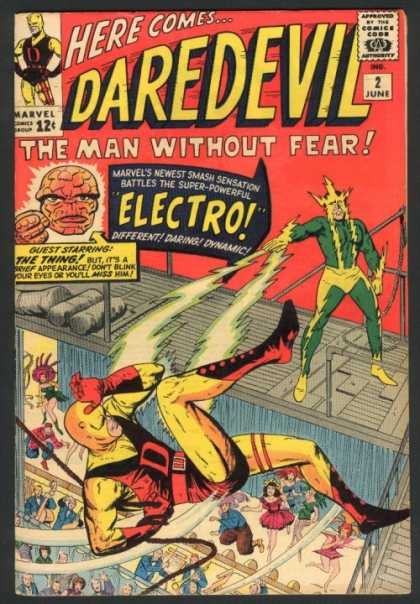
Are those buttons on his boots?
Does Electro’s lightning ever give off thunder?
How do shirts make a leather belt?
For the answers to these and other questions ask someone else!
He starts off with dealing with the plainclothes criminal who killed his father. Unlike Batman or Spider-Man, Daredevil avenges his father (figure). So if he wasn’t already inclined to fight crime, he would have stopped after avenging his father. The story would be over.
His second outing is against Spider-Man villain, Electro. Electro wears green and yellow and lightning bolts that create no thunder. He is eye candy and that attracts younger readers.
Then he faces the Purple Man, who is a wish fulfillment. Everybody has to do what you tell them to do. Every kid’s dream. But as a threat, Daredevil, being blind, can resist his power. A kid who can defy orders. I don’t know why he can do this, but I do know kids like to be able to resist orders.
In this issue, 4, is the first change to Daredevil’s costume. The buttons all fall off and his boots, instead of being red and being made of shirts, are black and not explained. Maybe they’re as leather as they always looked.
Next we have the Matador who is, in fact, just a plain matador with a mask. But his cape confuses Daredevil’s radar sense. His great weapon is a wavy piece of cloth. He throws this onto a windscreen so a truck driver crashes rather than just hits the breaks. This is children playing.
In this issue, 5, the second change is made to Daredevil’s costume. Instead of the single large ‘D’ on the chest, Wally Wood put on the interlaced capital D’s that would become synonymous with the character.
Then Daredevil faces Mr Fear with his two bully henchmen. Ox is big and dumb and everyone knew of that kind of bully somewhere and the Eel is so slimy he slides out when you grabbed him, literally flying into the air (how hard did you hug him?). This is basically what kids face: fear, big bullies, and people who are slimy and untrustworthy.
And that is the basic end of the first phase of Daredevil. With the very next issue, Daredevil undergos his first big makeover. It is virtually a second origin issue.
Start with the obvious: the costume. Gone is the yellow, black, and red costume made out of shirts. In its stead is an iconic all-red costume. The costume is all of one color, unique at the time, but it does pop up again with the Ted Kord version of the Blue Beetle created by Steve Ditko. Wally Wood just did it first.
And he did it well. Eye catchingis only half of it, there’s an attention to detail which is disguised by that simplicity. For example, look at the original big D, it’s in a Times New Roman typeface. The double D symbol is helvetica or calibri. It’s a more modern typeface.
Note the boots. They have a flat top, as opposed to the single peak at the front of the boot. His original ones were the same design as Batman’s boots. His new ones are a much simpler design.
The same with the gloves. Originally they came nearly to the elbow and, like the boots, had a single peak on one side. The new ones come to mid forearm and their top is a straight line, again in parallel to the boots.
The boots and gloves each have a single seam. In the boots this is clearly included for artistic effect. Boots do not normally have a seam down the middle from shin to toe (except Uggs), any more than your loafers have a seam down the middle. Gloves often have a seam along the side, but not always.
The gloves and boots have those seams in order to give them a sense of being three dimensional. The main area of the costume is red but it seems to be permanently in shadow. Despite wearing bright red everywhere, Daredevil is a dark figure. Compare this to Hourman, who wears yellow that is constantly in shadow. Daredevil is, in fact, more dark than the Blue Beetle, whose costume is a much cooler color.
The gloves and boots, by contrast, are bright red. Shadow runs all the way down the sleeve or leg and suddenly stops where the glove or boot begins.
Interestingly, this version of the costume is not only cleaner and sleeker, it is darker than the original. It is here that Daredevil is turned into a dark figure. Long before Miller put him in the underworld, Wood put him into the shadows.
The billy club was originally a stick. Daredevil used it to hit enemies. The handle could be straightened so no one would recognize it as a blind man’s cane which it wasn’t. Occasionally he would use it to knock a projectile aside with it. Near the end of his time in yellow and black he would also use it as a prop for acrobatics.
But now it became a far more powerful device with the addition of thirty feet of aircraft control cable. The end of the cane would now stay in one shape and it would be a grappling hook. The cable was a line and Daredevil would swing significant distances on that line. He would no longer run on rooftops dribbling his clothes like a basketball.
He was not only a dark figure, he was more mobile and could attack from above. Parallels with Batman and Spider-Man come to mind. The billy club now was a weapon and a mode of travel. It could not only strike or be thrown at an enemy, it could block attack, and give Daredevil a different angle for attack. It was an all-purpose weapon.
And what did Daredevil do with this new costume and this new, more effective weapon? He got his ass handed to him. Seriously, his first new opponent was Namor, the Sub-mariner. A thousand times stronger, bullet proof, didn’t just swing on a cable but literally flew, still had heightened senses, and he could see.
Daredevil’s great second debut is a loss to the Avenging Son, the Prince of Atlantis, the most dedicated nickname collector of all Marvel superheroes, Namor.
And he loses trying to protect soldiers who are about to fight Namor to the death (not his). He winds up prone talking to the dirt before he faints.
It is only that the Sub-Mariner admires Daredevil’s courage, fighting spirit, and determination that prevents a slaughter. “I’ll say, the bugger’s game of deserves a fair crack of the whip,” Namor doesn’t say because he isn’t Australian but it’s what he means. He has fellow feeling with a surface man and just flew over the soldiers and into the sea.
It is something early Marvel did which is not done much now. The superhero loses. Daredevil loses to Namor and Captain America loses to the Super Adaptoid. This was a more mature way of looking at things than is common now.
It is also much darker to see your hero lose then to have a slew of off-stage deaths of supporting characters. The hero losing is a Socratic dialogue in comic books.
Of course, Karen Page and Foggy Nelson are updated and get hairstyles of the current decade.
Thus Daredevil was reformed for the first time. We may remember the makeover Miller gave Daredevil, and remember it far better – even deservedly so. But the fact remains Daredevil received his first makeover in issue 7 of the comic. It was a significant event which has been overlooked by comic fans.
Partly this is because it was not as thorough as Miller’s remake. Miller changed everything that did not match his vision. At times his vision seemed to be only incidentally related to Daredevil.
So Wally Wood’s remake would stick with a few of the old tropes. For example, a known character would have his identity revealed. Witness the Organizer and the Masked Marauder. We also had silly villains like the Stilt Man. The four henchmen of the Organizer were the Cat Man, the Bird Man, the Frog Man, and the Gorilla Man – in other words, four common references to people through animals.
But witness the Gladiator, a villain who would cut Daredevil with a circular saw. Ka-zar and the Savage Land, the Ox in a much stronger role, Dr Doom, and Daredevil’s best opponents, Mr Hyde and the Cobra were a chalk and cheese tag-team of superstrong psychotics facing a psychotic.
That’s right, Matthew Murdock creates a fictitious twin brother, Mike Murdock, to keep his secret identity. Then he gets sucked into that world and never quite gets out. He’s still there, like when he digs up the corpse of his girlfriend. I have never done that.
Matt Murdock got adult problems, and they have become part of his character. He is not the swashbuckling adventurer he began as. He may laugh in the face in danger, but he also weeps in the face of tragedy. From the first forgotten makeover he became a character with more realism and depth and we owe Wally Wood as much as Frank Miller. However, Wally Wood had less control than Miller, since Wood operated within Stan Lee’s writing. If he hadn’t had to do that it would have been a very different arc for Daredevil. As it was, his work still shines through.

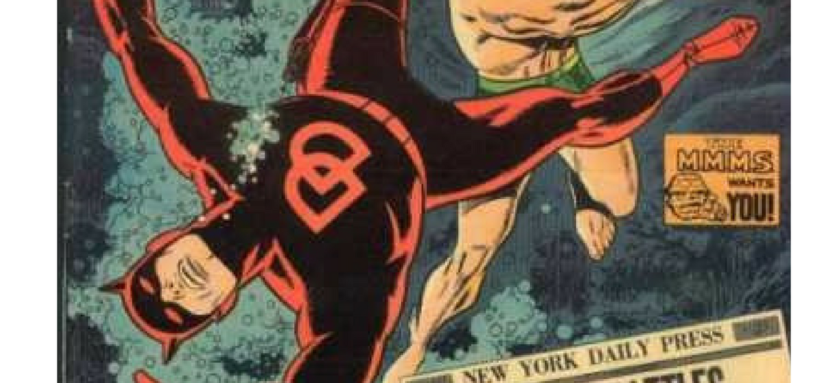

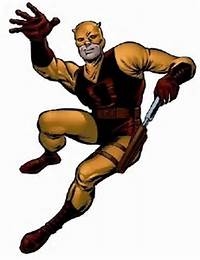
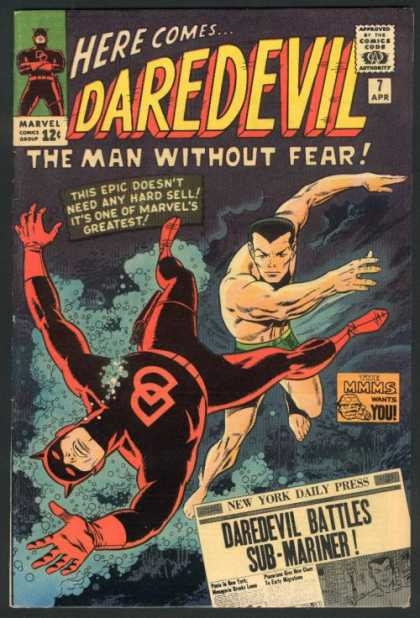
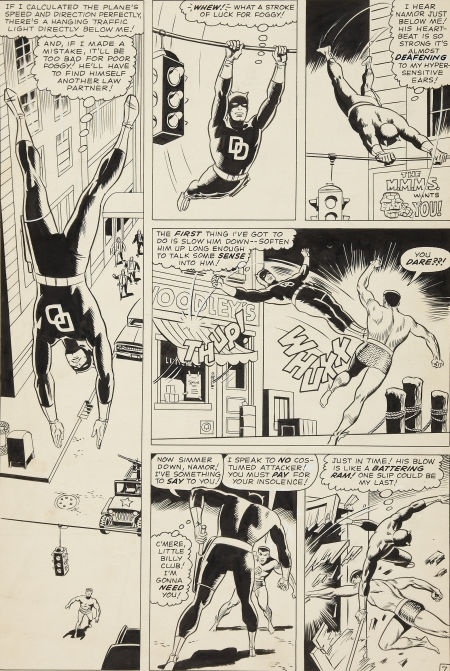
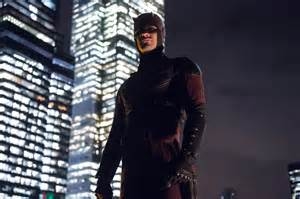
Comments are closed.